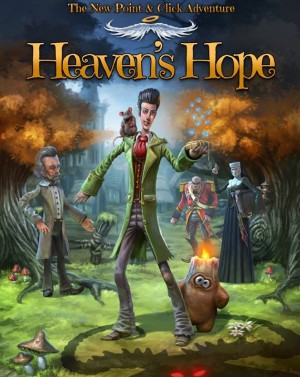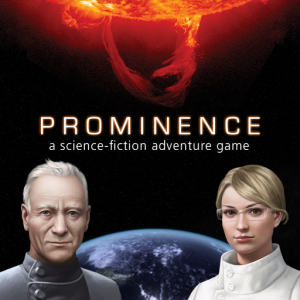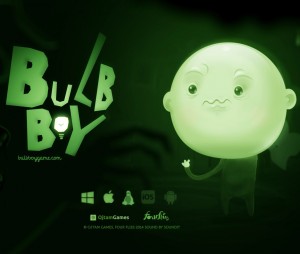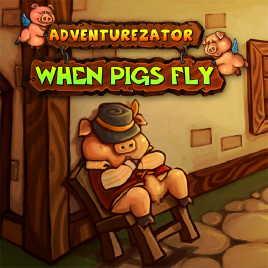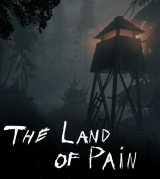Review for Heaven’s Hope
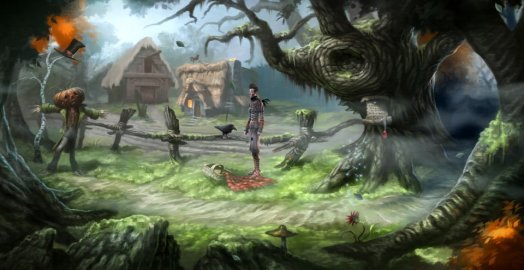
Though I’m not usually a fan of religious-themed entertainment, I willingly picked up Heaven’s Hope as it looked to have more of a fantasy bent, and I’m very glad I did. When the angel Talorel gets forcibly pushed out of Heaven by a jealous rival, he crash-lands on earth and proceeds to wreak accidental havoc in his attempt to get back home. The result is a fun point-and-click romp through gorgeous hand-painted scenery, though it’s not without some rough edges that keep it from fully soaring.
The plot of Heaven’s Hope picks up after Talorel arrives on earth, with just a quick cutscene showing how he was maliciously shoved through the barrier by a fellow angel. Unfortunately, Talorel is completely clueless about life in the human realm, as well as basic concepts such as space, time and matter, and both his halo and wings were burned in the fall. So what’s an angel to do? Luckily, Talorel still has a little angelic ability, as well as the assistance of his two best friends, Azael and Salome, fellow angels who keep him company (from above) and offer advice throughout his adventure.
Talorel lands next to the town of Heaven’s Hope, which is undergoing a vicious revival of the Inquisition by the overzealous nun, Greta. As the fallen angel makes friends with the town’s resident mad scientist, Bloomford, he inadvertently gets wrapped up in the midst of Greta’s Inquisition in his quest to build a flying machine to get back to Heaven. Slightly outlandish but always entertaining, the game manages to establish an off-kilter world with a story that can’t help but be charming. And while some of the humor misses the mark, perhaps lost somewhere in translation from its original German, the overall game is quite amusing, particularly the unexpected references to things like Monty Python and Sesame Street.
The characters of Heaven’s Hope are rich and varied. From the naive yet cheeky mischief-maker Talorel, to the earnest farmer Bill, to the really-out-of-place Chinese silk mistress Mai-Lin, each person is given a distinct personality and has a specific role to play in the plot. No one besides Talorel is given much depth, but it isn’t needed; everyone has a function in his journey and each fills their role beautifully. Considering the game takes place during the late 1800s somewhere in rural Europe, the cast is more diverse than I was expecting, which is a huge plus. There are also two non-speaking characters, a resurrected mouse that Talorel unofficially nicknames Furball and a homunculus named Anselm, both of whom help him on his quest. Each is chock-full of personality despite not having a single line of dialogue, a feat that is difficult to pull off successfully.
The basic mechanics are easy enough to grasp, even without a tutorial as such in the game. Hovering your cursor (in the shape of an angel wing) over an object you can interact with brings up one or two icon options above it: lips to talk, an eye to see, breath to use your angel power, etc. Clicking the desired option has Talorel perform that action. To see all available hotspots on the screen at any time, holding down the spacebar highlights them. You also get a very basic map which you can use to fast travel, and a journal to keep tabs on the adventure as you go along. Clicking on the question mark in the top right-hand corner of the screen provides a hint from either Salome or Azael.
The puzzles are all quite varied, with only one challenge repeating itself, which is nice, though of course there are also plenty of inventory puzzles throughout, requiring you collect and use items. For the most part they follow the logic of the game, and once you are able to put yourself in that mindset they’re not too difficult to solve. However, a few are rather bizarrely unintuitive and therefore artificially challenging. The special angel abilities Talorel possesses are needed to solve puzzles, as is using Furball and the homunculus Anselm. Along with talking to plants and animals, Talorel can use his angel breath to bring things to life and to activate religious markings, while Anselm and Furball are able to get into tiny spaces that Talorel cannot, in addition to providing extra bodies when one just isn’t enough. Along the way, there are also two shooting challenges which are skippable, a slider puzzle and a Rube Goldberg-type machine that must be repaired.
Unfortunately, the puzzle controls are perhaps the weakest point of the game, turning some tasks from what should have been enjoyable exercises into frustration. The same movement method is used throughout, thus when I would have preferred to navigate an obstacle course using the arrow keys, I was forced to continually click where I wanted the character to go. That may sound easy, but clicking your way through a 3D obstacle course on a 2D screen is ineffective and finicky; you have no way to get your character to move to the side when they interpret a mouse click as moving backwards at certain points. A particular door puzzle is also made unnecessarily difficult, as there are multiple hotspots close together to interact with, and it’s frustrating having to focus on such precise mouse movements instead of solving the actual puzzle.
While the hint system has no technical flaws, it doesn’t really provide adequate hints for solving puzzles. If you are stuck on where to place cogs in the door puzzle, tough luck; Salome and Azael only tell you that you need to get out of the room. Additionally, if you’re unsure about where to find something to advance the plot, or even what you’re supposed to be looking for, they offer no specific help for that either. So while a nice idea in theory, the hint system ends up being practically useless when you really need it. There is a much more helpful skip option for two or three challenges that somewhat over-zealously kick in if you don’t get it right within a minute or two, which I ended up very much appreciating for the obstacle course.
The pretty backgrounds are all hand-painted and the characters animated in 3D, though drawn in the same style as the environments so the two mesh together perfectly. A darker color palette is used, with a lot of greys and muted greens; Talorel’s “borrowed” green jacket is pretty much the brightest part of the landscape. The whole town has a stylized, crooked feel to it, with not many straight lines used in any of the structures. There is a small amount of ambient animation, mainly characters moving around and the occasional bird to make the world feel more alive, which is a nice touch.
All locations are set in and around Heaven’s Hope, both indoor and out, including scenes of a windmill, a bell tower, thatch-covered homes, cobblestone streets, a cemetery, and more. But my favorites are by far the library and the science lab, as both are packed with detail. The library is charming and evokes a quiet, old-style feel with comfy chairs and lamp lighting, and the laboratory is eclectic in its decor, consisting of both scientific instruments and random junk left lying around.
Character models are quite varied, with no two looking even remotely similar. Talorel seems to have been vaguely inspired by Tim Burton, though part of that could be the combination of “burned-up crash outfit” and “clothes I’ve stolen from a scarecrow” attire. Vladic, the rotund town smuggler, should have looked ridiculous in his enormous coat, red scarf and oversized top hat, but it actually works. The cutscene flashbacks of heaven are hand-painted as well, though in a sketchier, rougher style than the game itself. Really the only problem with the visual presentation is that it snaps out of sync with the audio at several points, leaving the characters moving their mouths after they’ve stopped talking, which looks really strange.
Voice acting for the various characters is passable, with some performances definitely stronger than others. There are a few places where the delivery trips up, particularly for Salome and Azael, but I wouldn’t classify even these as “bad” by any means. Talorel’s off-beat delivery is endearing and in keeping with his awkwardness as a whole. The music and sound design are nicely done, but I must admit I noticed the sound effects more than the actual background score, which sometimes leaves lengthy periods of silence in between. Effects are frequent, though: I loved the squeaks that little Furball made every time I used her for something, and I found the strange “blorp” sound when using items pretty funny, at least after the first couple times when I thought I’d broken something.
There are a few translation errors in the subtitles, mostly typos which don’t affect gameplay and aren’t frequent enough to be really irritating. However, some things have clearly been translated differently, such as “resuscitated” instead of “resurrected.” You can tell what the original intent is in most of the discrepancies, but there were a few times I suspected the translation actually interfered with my understanding, specifically during a puzzle that involved rearranging urns in the cemetery. These issues are more of the frustrating sort than the “throw the game down in anger” variety, but it does display an unfortunate lack of polish.
Overall, Heaven’s Hope is an entertaining and beautiful game, with an interesting plot hook, engaging characters and only a few design and technical weaknesses holding it back. It’s fairly lengthy, too, taking me approximately 12 hours to complete, and still leaves room at the end for the possibility of a very welcome sequel. Despite the implied subject matter, there are very few religious themes throughout, and nothing at all preachy about the story, so anyone can enjoy it. If you’re a fan of classic adventure games, a fantasy enthusiast or just interested in angelic mythology, this game may just be the answer to your prayers.




